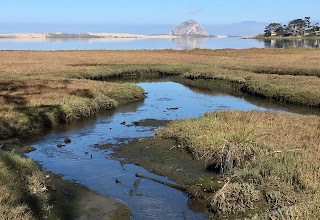The Morongo Canyon Preserve is located directly off of the Twentynine Palms Highway (Hwy 62) in the high desert town of Morongo Valley, California. The Preserve is a 31,000 acre native plant and wildlife habitat, situated in the transition zone between the high Mojave Desert and the lower Colorado Desert section of the Sonoran Desert. In other words, it is in the semi-high desert .
Natural Springs, when not suffering from drought, feed a desert oasis of native California Palm, Cottonwood, Willow, Mesquite, extensive patches of Alkali Goldenbush, (below) and a riparian habitat that create a cool and moist environment for birds, wildlife, and birders. The Preserve is well known among the bird watching world; over 247 different species have been observed at Big Morongo.
The weather was perfect for birding, a slightly warm morning accompanied by a cooling breeze. Anticipating the temperature to be hot, Cathy, my Palm Springs friend, and I were delighted at the coolness. Is Cathy looking at a bird? No! It's was a tiny bright green grasshopper. In some areas birds were a bit sparse.
Unfortunately, drought and fire had taken a toll on the vegetation, but the hardy plants, especially the Mesquite and the California Palm, were coming back to life.
Best birds on our walk were Black-and-White Warbler and a male and female Phainopepla, the male was in flight, the female perched on a twig. We were alerted to their presence by a one syllable call, similar to a whistle. A primary source of food for the Phainopepla are mistletoe berries. Both the Cottonwood and Mesquite trees are hosts to the parasitic mistletoe.

The Black-and-White Warbler was active in a blooming patch of Alkali Goldenbush that was humming with insects.
Two feeding stations in the Preserve gave birders a chance to sit comfortably while practicing the art of birding. Feeders held seeds, peanuts and suet; Hummingbirds had their choice of several feeders, and for birds with a sweet tooth, such as Woodpeckers, Orioles, and Tanagers, a hanging basket with a bowl of grape jell; water stations used by both birds and wildlife were numerous. In the above photo, the black object keeps the squirrels out of the feeders.
It was tremendous fun birding the feeders. A few of the birds we saw were Black-chinned Hummingbird, Mountain Chickadee (uncommon), White-breasted Nuthatch, Fox Sparrow, Lincoln’s Sparrow, Rose-breasted Grosbeak, and one very special bird.
We were sitting, chatting with other birders (above photo), enjoying the little brown, grey, and black and white birds when suddenly there appeared at the grape jelly feeder, a brilliantly red, Summer Tanager (photo below) Well, that made our day - a first sighting for both of us. (the man in the center is using a monocular.)
Birding the Big Morongo Preserve was a rewarding experience that I hope to repeat next spring when Vermilion Flycatchers arrive to nest in the Cottonwoods.
The Big Morongo Preserve is included in the 154,000 acre Sand to Snow National Monument.
https://en.m.wikipedia.org/wiki/Sand_to_Snow_National_Monument



















































